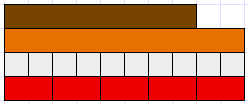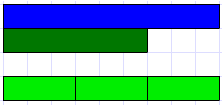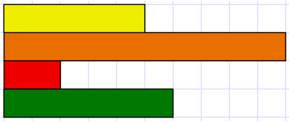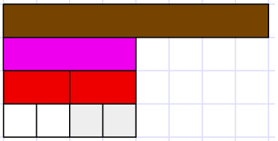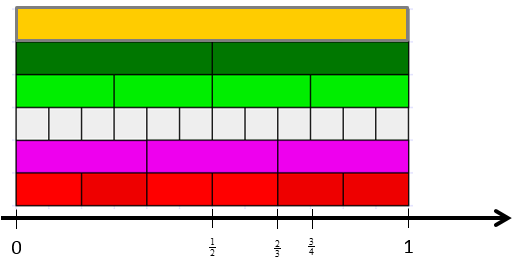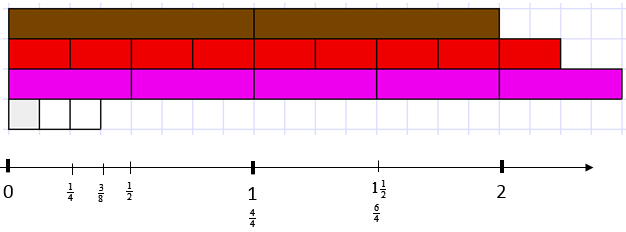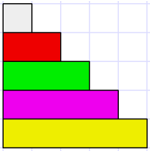This unit introduces the idea that fractions come from equi-partitioning of one whole. Therefore, the size of a given length can be determined with reference to one whole. When the size of the referent whole varies, then so does the name of a given length.
- Name the fraction for a given Cuisenaire rod with reference to one (whole).
- Find the one (whole) when given a Cuisenaire rod and its fraction name.
- Create a number line showing fractions related to a given one (whole).
- Identify equivalent fractions
‘Fractions as measures’ is arguably the most important of the five sub-constructs of the concept of rational number (Kieren, 1994) since it identifies fractions as numbers, and is the basis of the number line. Fractions are needed when ones (wholes) are inadequate for a given purpose (e.g. division). In measurement, lengths are defined by referring to some unit that is named as one. When the size of another length cannot be accurately measured by a whole number of ones, then fractions are needed.
For example, consider the relationship between the brown and orange Cuisenaire rods. If the orange rod is defined as one (an arbitrary decision) then what number is assigned to the brown rod?
Some equal partitioning of the one is needed to create unit fractions with one as the numerator. For the size of the brown rod to be named accurately, those unit fractions need to fit into it exactly. We could choose to divide the orange rod into tenths (white rods) or fifths (red rods). By aligning the unit fractions we can see that the brown rod is eight tenths or four fifths of the orange rod.
Note that eight tenths and four fifths are equivalent fractions and the equality can be written as 8/10 = 4/5. These fractions are different names for the same quantity and share the same point on a number line. The idea that any given point on the number line has an infinite number of fraction names, is a significant change from thinking that occurs with whole numbers. For the set of whole numbers, each location on the number line matches a single number. Some names are more privileged than others by our conventions. In the case of four fifths, naming it as eight tenths aligns to its decimal (0.8) and naming it as eighty hundredths aligns to its percentage (80/100 = 100%).
Specific Teaching Points
Understanding that fractions are always named with reference to a one (whole) requires flexible thinking. Lamon (2007) described re-unitising and norming as two essential capabilities if students are to master fractions. Re-unitising enables students to flexibly define a given quantity in multiple ways by changing the units they attend to. Norming enables students to operate with the new unit. In this unit of work, Cuisenaire rods are used to develop students’ skills in changing units and thinking with those units.
Consider this relationship between the dark green and blue rods. Which rod is one? Either could be defined as one and the other rod could be assigned a fraction name.
If the blue rod is one then the dark green rod is two thirds, as the light green rod is one third. If the dark green rod is one then the blue rod is three halves since the light green rod is now one half.
Re-unitising and norming are not just applicable to defining a part to whole relationships like this. In this unit students also consider how to use re-unitising to find the referent one and to name equivalent fractions. For example, below the crimson rod is named as two fifths. Which rod is the one (whole)? If the crimson rod is two fifths, then the red rod is one fifth. Five fifths (red rods)form the whole. Therefore, the orange rod is one.
What other names does two fifths have? If the red rods were split in half they would be the length of white rods, and be called tenths since ten of them would form one. The crimson rod is equal to four white rods which is a way to show that 2/5 = 4/10. If the red rods were split into three equal parts the new rods would be called fifteenths since 15 of them would form one. The crimson rod would be equal to six of these rods which is a way to show 2/5 = 6/15. The process of splitting the unit fraction, fifths in this case, into equal smaller unit fractions, produces an infinite number of fractions for the same quantity.
The learning opportunities in this unit can be differentiated by providing or removing support to students, by varying the task requirements. Ways to support students include:
- providing Cuisenaire rods for students to manipulate when solving problems
- modelling how to record fraction symbols and drawing attention to the meaning of numerator and denominator
- drawing diagrams to clarify the unit of comparison and the one (whole) in problems
- encouraging students to work collaboratively, especially where some students are affected by colour blindness.
Tasks can be varied in many ways including:
- altering the complexity of the rod relationships that students work with. Working with halves and quarters tends to be easier than with thirds and fifths
- providing 1cm2 grid paper and coloured felt pens to ease the recording demands (Cuisenaire rods are based on that scale).
The contexts for this unit can be adapted to suit the interests and cultural backgrounds of your students. Cuisenaire rods (rakau) are often used in the introduction of te reo Māori, meaning they may be familiar to some students. Knowing the relationships between rods of different colours, without having assigned number names to the rods, is very helpful in easing cognitive load. Other contexts involving fractions of lengths might also be engaging for your students. For example, the fraction of a race or journey that has been covered at different points is practically useful. This could be linked to the early journeys of Māori and Pasifika navigators to Aotearoa, or to current journeys your students have experienced (e.g. a bus ride to camp, running a lap of the playground). Consuming foods that are linear, such as submarine sandwiches, bananas, or sausages, might motivate some learners. Board games that have a particular number of steps from start to finish provide opportunities to look at a fraction as an operator.
Te reo Māori vocabulary terms such as hautau (fraction), hautau waetahi (unit fraction), hautau waetahi-kore (non-unit fraction), rākau Ātaarangi (Cuisenaire rods), hautau ōrite (equivalent fractions), rārangi tau (number line), and the names for individual fractions could be introduced in this unit and used throughout other mathematical learning.
- 1 cm squared paper.
- Cuisenaire rods or access to the online Cuisenaire rods tool.
- PowerPoint
- Copymaster 1
Prior Experience
Students may have mixed experiences with using Cuisenaire rods. When introducing the Cuisenaire rods, ask students to think about what they could be used to represent in mathematics. Value the contributions of all students.
Session One
- Use Cuisenaire rods or the online tool to introduce the relative size of Cuisenaire rods in the following way. Provide whiteboards or paper, or use a large chart or whiteboard, to record students thinking.
Relative to the orange rod, how long is the yellow rod? How do you know? Justify
The relationship between the yellow and orange rods can be expressed in two ways:
“The yellow rod is one half of the orange rod.”
“The orange rod is two times the length of the yellow rod.”
If the orange rod was one, then the yellow rod would represent one half.
What fraction would the red rod and dark green rod represent? Justify.
- Encourage the students to express the relationships in various ways, such as:
“The red rod is one fifth of the orange rod because five of it fit into the whole (one)”
“The orange rod is five times longer than the red rod.”
“So the dark green rod must be three fifths of the orange rod because three red rods make one dark green rod.”
A more complex question is “How many dark green rods (three-fifths) fit into the orange rod (one)?” While the correct answer is five-thirds, or one and two thirds, students will be unlikely to name the relationship that precisely. Expect answers like “Almost two but not quite.”
- Introduce Investigation One using Slide 1 of the PowerPoint. Encourage students to record both their names for each rod (relative to the brown rod) and their reason for naming it that way. Provide sets of Cuisenaire rods or access to the online tool. Let the students collaborate in small groups (mahi tahi). Consider pairing together more knowledgeable students with less knowledgeable students to encourage tuakana-teina (peer learning). Look for the following:
- Do the students refer back to the brown rod as the one?
- Do they name each rod with reference to how many times it fits into one?
- Do they use the relationship between rods to name them? (For example, if pink is one half then red must be one quarter and white must be one eighth).
- Can they name a rod larger than one as an improper fraction or mixed number? (For example, the orange rod now represents one and one quarter (1 1/4 or 5/4).
- All of the points above can be raised in discussion as a whole class. Extend the conversation to which rods were hardest to name and why that was so. For example, the light green rod does not fit into the brown rod an exact number of times but the white rod (one eighth) can be used as a reference.
- Also discuss equivalence. The diagram below shows 1/2 = 2/4 = 4/8. Explain that equivalent fractions are different names for the same quantity.
Session Two
- Revise the key points from the previous session using the blue rod as one.
- Ask questions like:
If the blue rod is one what do we call the light green and white rods? Justify your answers.
What statements can you make about the relative size of the rods?
Are there equivalent fractions in the picture (1/3 = 3/9)? So what fraction is equivalent to… two thirds? (2/3 = 6/9), … to three thirds? (3/3 = 9/9).
Students might notice some patterns in the symbols such as the same multiplier between numerators and denominators in the equalities.
- Reflect back on fractions where the rod was larger than one. Ask: If blue is one then what fraction is the orange rod?
Thinking that fractions are restricted to less than one is a common constraint students learn. Therefore, opportunities to name fractions greater than one (i.e. mixed or improper fractions) is important. This thinking could be supported by making links to different ‘whole’ items that are different sizes (e.g. two different waka). Linking this learning to contexts that are relevant to your students will increase the level of meaning they can see within this unit. Just like the Cuisenaire rods, they are different sizes, but can still be classified as ‘one whole’. Students might recognise that the white rod fills the gap between the blue and orange rods.
Useful questions are:- Remember, which rod is one?
- So what fraction is the white rod? (1/9)
- How many white rods fit into the blue rod? (nine)
- How many white rods fit into the orange rod? (ten)
- So what shall we call the orange rod? (1 1/9 or 10/9)
- Ask students to attempt Investigation Two of the PowerPoint (Slide 2). Remind them of the necessity for recording their solutions and justifications.
- As they investigate in small groups, roam and look for:
- Do they accept the new imaginary rod as one?
- Do they name the other rods as unit fractions in terms of how many of that rod fit into one?
- Do they know how to name non-unit fractions using copies of unit fractions? E.g. Three quarters (blue rod) is three copies of one quarter (light green).
- Do they realise that equivalent fractions are different names for the same quantity?
- Share the results as a class attending to the points above.
- Construct a fraction wall with the gold rod as one. Name each unit fraction (1/2 ,1/4 ,1/12 ,1/3 ,1/6). Ask if these are the only unit fractions that are possible and why that is so. Students may note that the denominators are all factors of 12. Look for equivalence in the fractions within the wall. Encourage students to find non-unit fraction equivalence as well, e.g. 2/3 = 8/12 and 3/4 = 9/12.
- Use the wall to create a number line as shown. Ask:
How much more three quarters is than two thirds?
How much less one half is than two thirds? - As a class, come up with a real-life context that could be represented by a fraction wall. It does not have to be completely realistic, but it should reflect the relevant learning interests and/or an element of the socio-cultural backgrounds of your class. For example, the one whole is the number of students in the class, ½ want to go to the beach for a class trip and ½ want to go to the museum. ¼ of the students who want to go to the beach want to swim, and ¼ want to build sandcastles. As you develop this scenario, use groups of students to represent the division of the “whole” (i.e. the whole class) into different fractions. This will present opportunities for students to compare the sizes of different fractions, in relation to the number of students in your class.
- Let students work on Investigation Three from the PowerPoint. Their work will extend into Session Three. Look for the following:
- Can students name the fractions for the rods that are being joined?
- Can they record the combinations as sums like, 1/2 + 1/3 + 1/6 = 1?
- Can they use equivalence, particularly referring to twelfths, to explain why the combinations add to one?
Session Three
In this session the purpose is to reconstruct the one rod. Students connect from part to whole as opposed to whole to part.
- Begin by going over previous ideas in the context of this model.
- Ask: What are the size relationships between the yellow and black rods? Allow students to discuss this in pairs. Some students may want to use the relevant rods to model their thinking.
The students might use the white rod as a reference to say, “The yellow rod is five sevenths of the black rod.” It is more difficult to recognise that “The black rod is seven fifths of the yellow rod.” The key idea is to establish the referent one. If a comparison ‘of a given rod’ is being made then that rod becomes the one.
- Ask: So if you were told that the yellow rod was five sevenths of the one rod, what colour would the one rod be? (black).
If you were told that the black rod was seven fifths of the one rod, what colour would the one rod be? (yellow)
- Provide another scenario. If you were told that the pink rod was one half of the one rod, what colour would the one rod be?
Students might easily recognise that two halves make one so the rod colour of one is brown. This is an easy scenario as a unit fraction is given. Therefore, ask a harder problem like this:
If you were told that the dark green rod was two thirds of the one rod, what colour would the one rod be?
The dark green rod does not fit exactly into the mystery one but half of it does. That half of the green rod is the light green rod (one third). So the one rod must be blue.
- Ask the students to complete Copymaster 1 in pairs or threes. Point out the need to justify their decisions about which rod is one in each case. Students need to use Cuisenaire rods or the online tool for this activity. They should not rely on the pictures being to scale. Look for:
- Do they adjust to the variable one in each case?
- Do they use the given rod as a unit of measure?
- Do they subdivide the visible rod to find a unit fraction they can measure with? For example if told the rod is two thirds, do they divide the rod equally into two parts to create a one third measure?
- If students complete Copymaster One, ask them to create similar part to whole problems for other students.
Session Four
The aim of this session is to develop students’ mental number line for fractions. Inclusion of fractions with whole numbers on the number line requires some significant adjustments. Activities using a number line could be completed digitally (e.g. on a PowerPoint or flipchart), or with the use of a whiteboard or paper chart. These adjustments include:
- A point on the number line can have an infinite number of names called equivalent fractions, for example, 2/3 ,4/6 ,6/9 … all ‘live’ at the same point.
- Between any two fractions are an infinite number of other fractions (this is known as ‘density’ of the number line).
- Begin by building up a number line for quarters in this way.
If the brown rod is one (mark zero and one on the number line) where would one quarter be?
Students may now know that the red rod is one quarter of the brown rod. Ask: What fractions could be marked on the number line using one quarter? Look for them to explain that quarters can be ‘iterated’ (place end on end) to form non-unit fractions. Make sure you push the iteration past one and include the fraction and mixed number ways to represent the amount (see below). Also encourage renaming in equivalent form where this is sensible, for example, 2/4 = 1/2, 4/4 = 1.
- Look at the space between one quarter and one half. Ask, “Are there any fractions that belong in this space?” Students may recognise from previous work that white rods are one eighth of a brown rod. Three eighths will work. Note that three eighths measure exactly half-way between one quarter and one half. Ask, “What fraction would belong half way between one quarter and three eighths?” (five sixteenths). The last question requires students to use their imagination, as there is no rod that is half the length of a white rod.
- Show the students the diagram on Slide 4 of the PowerPoint. It shows zero and two fractions (orange rod as two thirds and blue rod as three fifths placed on a number line. Ask, “How could we find the length of the one rod?” From the part-whole task in the previous session students should reply that one third or one-fifth need to be located by equally partitioning the orange rod in two parts to get the yellow rod or equally partitioning the blue rod into three parts to get the light green rod. These unit fractions can then be iterated to get the referent one (three yellow rods or five light green rods).
- Ask students to create a number line with the orange rod as two thirds and the blue rod as three fifths. They must include one and any other fractions they can find. In the event of early finishers to this infinite task, provide the following challenge fractions to locate on the number line: 4/3, 9/5, 3/15, 14/15, 2/9. Look for the following:
- Do the students use fifths and thirds as unit fractions to locate other non-unit fractions, like four fifths?
- Do the students find fractions greater than one by iterating unit fractions?
- Do the students record equivalent fractions in the same location, for example five fifths and three thirds at one?
- Do the students subdivide unit fractions to form other units, for example divided thirds into two equal parts to form sixths?
- Do the students attempt to identify fractions between fractions, for example, which fractions lie between two thirds and four fifths?
- Bring the class together after a suitable period of investigation to share results. You will need a large number line on the whiteboard. By the time the discussion is over you should saturate the number line with fractions. You may like to ask if it ever possible to complete this task. Students may already realise that there are an infinite number of fractions that could be located. As an extension, you could refer back to the whole-class wall fraction you created, and represent the different fractions on a number line.
- After discussing the fractions that can be located on the above number line ask the students to make up a similar number line problem for someone else. The problem must include enough fractions already placed to locate the referent one and at least six other fractions to be located on the line. They are free to choose whatever rod they want as the one and may even create a rod that is not in the set. Challenge them to frame their problem in relation to the context which framed your whole-class fraction wall.
Dear family and whānau,
This week students will be learning about fractions, like three quarters and two thirds. We will be using some materials called Cuisenaire rods which are lengths of plastic or wood. They look like this:
Your child should be able to name fractions of a given rod. For example, they might say that the light green rod is three fifths of the yellow rod.
There is an online tool that lets you play with Cuisenaire rods on this page:

